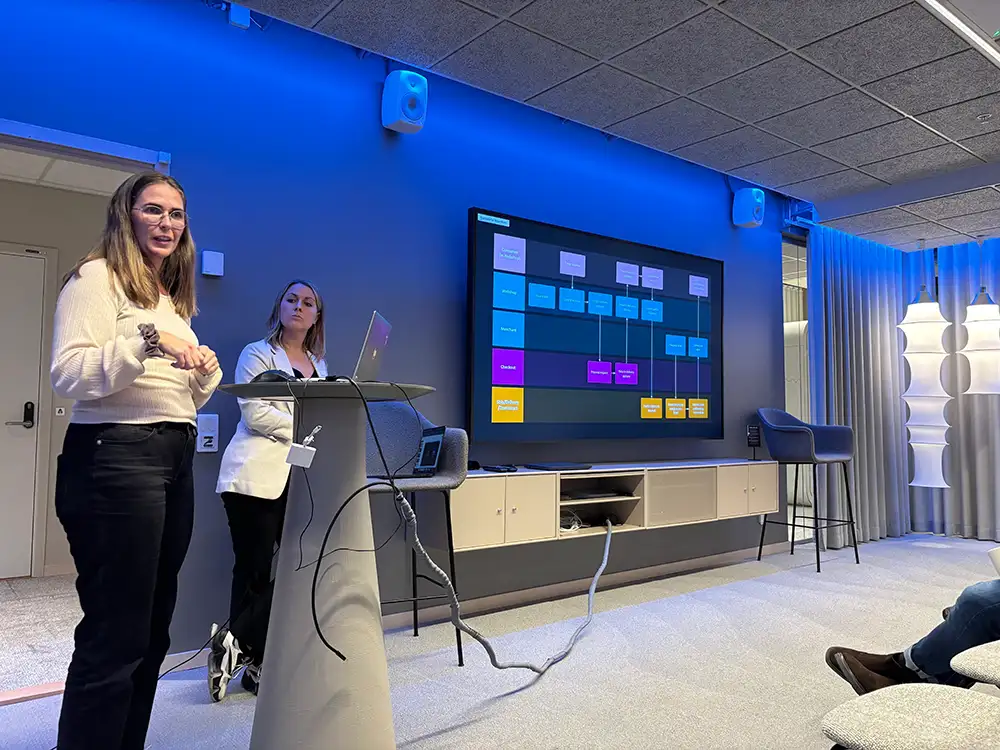
Last update: 04.08.2025
In this blog:
- Intro
- The birth of EDI
- Transforming EDI engines
- API’s are the new black
- The delivery management market today and its demands
- Conclusion
- Further reading: EDI integration FAQs
Intro
This is the story behind delivery management software and how it in just 20 years has evolved from very basic file transfer to end-to-end software solutions catering to the entire delivery process from online checkout to delivery and return. In the beginning, the carriers were a huge accelerator for this evolution but the increase in ecommerce has put even greater demand on the innovation of these solutions and will continue to push the development within this field going forward.
The birth of EDI
The first wave of digitalization of communication between shippers and carriers came during the late 1990’s. The original focus was on EDI messages containing the information a carrier needs for correct billing of the transportation services, thus making the invoicing processes of the carriers more efficient. The data set exchanged was relatively simple, limited to what would normally be found on the waybill and communication was asynchronous, sending all the information in one message. The carriers benefited the most from the first wave and they were also the driving force behind it. In some markets, like the Nordics, the carriers were even able to enforce a “non-EDI surcharge” for shippers not able to communicate digitally.
Bigger shippers would often choose to generate these EDI messages directly from their own back-end systems. As a result, they became limited to using only a few carriers, and any change came with a significant internal IT cost. The shipper would also have to generate a shipping label that could be accepted by the carrier, even if it often didn’t fully meet the carrier’s specifications. So called track and trace data, i.e. status events sent back from the carrier, was usually not implemented leaving the shipper completely blind once the goods had left the warehouse. The result of the direct EDI approach was a very rigid system hindering both the carrier and the shipper from developing and improving the delivery process.
Transforming EDI engines
The alterative to direct EDIs was to use one of the emerging companies providing what is now called delivery management or multicarrier parcel management solutions. These products were at the time essentially EDI engines combined with a validation framework used to safeguard the quality of the data sent to carriers and a label generator. Such solutions were developed with support from, and in close cooperation with carries and they allowed also smaller shippers to start making electronic bookings and helped all shippers to generate correct EDIs and compliant labels.
The development of more advanced transport services including features like complex routing rules, track and trace, pick-up and drop-off (PUDO) points, reservation of delivery slots and a growing number of additional services has since then then made the generation of correct booking messages, not to mention correct labels and transport documents, much more complex. Anyone attempting to build file-based integrations to a modern carrier must be prepared to implement complex validation rules, complicated label layouts, and to store significant amounts of supporting data which must be kept up to date. It is simply not economically viable for an individual shipper to build and maintain bespoke connections.
API’s are the new black
The second digitalization wave came with the introduction of application programming interfaces, commonly known as APIs. Most carriers have spent the last ten years developing their own set of APIs targeting shippers. The original intention was to replace direct shipper-carrier EDIs with direct API integrations, but the actual result has been an acceleration of the transition towards third party intermediaries. The industry had now also reached a point when track and trace information, i.e. status events fed back from the carriers, was a natural part of the carrier-shipper integration scope.
There are no market standards defining how to build a set of carrier APIs and each carrier has their own structure and logic. As a result, many shippers have found that their old school, home built, file integration approach is insufficient when they try to connect to modern last mile actors or even just trying to access the latest services offered by any major carrier on the market. This forces shippers to use carriers that only offers APIs and thereby abandon their legacy integration strategy and turn towards a modern solution.
The delivery management market today and its demands
The pace of innovation is currently very high in the transportation business, spear-headed by the last mile delivery domain. Consumer (receiver) control and fast or even “instant” delivery options introduce new requirements on the communication between the shipper and the carrier. It’s no longer enough just to integrate the WMS or TMS to the carrier and to send data at the end of the day when all parcels and pallets are packed and ready to ship. The communication with the carrier must start already from the customer facing interface such as the web shop checkout and the whole fulfillment chain must be in sync to make sure that the promises made to the customer can be met.
Another result of the highly dynamic transport market is that no shipper can rely on only one or a few carriers. Gartner® states that “Leveraging multiple carriers and services is crucial to providing the best options and offering the most competitive shipping costs”. (Gartner, “Market Guide for Multicarrier Parcel Management Solutions” Bart De Muynck, Oscar Sanchez Duran, Simon Tunstall, 2021-02-02) It’s simply not possible to find a carrier that checks all the boxes on all the markets, especially since the receiver now weighs in on the carrier selection.
Conclusion
It’s during the second wave driven by APIs and delivery innovation that the adaptation of delivery management solution really has taken of. The market leading delivery management providers have been fast to extend their offerings to include not only booking of transportation and printing of labels, but to span all the way from the point of sales until the very end of the delivery chain, including the returns, and to provide visibility and control over every step along the way.
The true reason to be for a modern delivery management product is to help shippers cope with all the complexity coming from a wide carrier supplier base, constantly changing technical interfaces and transport service definitions, multiple internal systems, and most importantly rapidly increasing demands from customers. It’s simply impossible for a shipper to acquire and defend a competitive delivery offering without the help of a delivery management provider.
It’s all in the delivery
From checkout to emissions, nShift gives you full control of delivery management at every step — with branded experiences, smarter shipping, and access to 1,000+ carriers.
Explore the nShift platform
Further reading: EDI integration FAQs
What is EDI file transfer in delivery management software?
EDI (Electronic Data Interchange) enables structured, automated document exchange—such as shipping notices, orders, and invoices—between systems (e.g. ERP to DMS). It ensures compliance and high data integrity without manual input.
Which protocols support EDI integrations?
Common protocols include AS2 for secure, push-based internet transfer and OFTP/OFTP2—widely used in European logistics for encrypted, cross-border file exchange.
How does EDI improve delivery workflow automation?
EDI eliminates manual data entry, enabling instant document exchange (e.g., orders, ASNs, shipping labels). This accelerates fulfillment, reduces errors, and increases reliability.
What operational benefits can businesses gain from EDI integration?
Key advantages include cost savings from reduced labor, fewer chargebacks, compliance automation, faster cash flow via real-time invoicing, and enhanced partner collaboration.
How does EDI support real-time visibility in deliveries?
EDI offers real-time updates on shipment statuses, inventory levels, and document acknowledgments, enabling proactive decision-making and improved customer service.
Is EDI compatible with modern SaaS delivery platforms?
Yes. Many delivery solutions now offer SaaS-based EDI (or EDI-as-a-Service), enabling seamless integration with ERP/WMS systems without heavy on-prem infrastructure.
How does EDI enhance data accuracy and reduce errors?
Standardized EDI formats minimize manual input errors, while automated acknowledgments and built-in validation greatly improve accuracy and reduce processing delays.
Why is EDI important for compliance and document security?
EDI protocols like AS2 and OFTP2 support encryption and digital signatures, ensuring data security. Standardized formats also simplify compliance with global trade and data-sharing regulations.

About the author
Johan Hellman
VP Product Management
Johan has 15+ years of experience within the logistics and shipping industry, holding senior management roles across 3PL, TMS, Supply Chain and Carrier Management. At nShift, Johan is responsible for our world-leading carrier network, including the pre-built connections to carriers and transport service providers worldwide.






